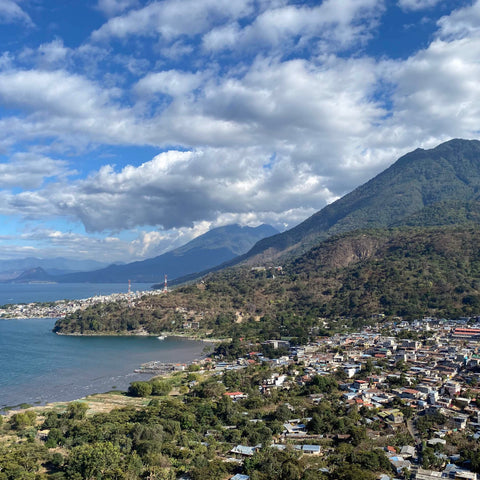
STORY Sam
WORDS Harrison
Hey all, Sam here.
I've been thinking a lot about how to create meaningful relationships with the people that specialty coffee has always aimed to support: the farmers. Obviously, gathering your roastery's beans ethically and buying as close to the source as possible is a really great place to begin, and with the constraints of a small team, most coffee companies can only manage these steps when looking after their supply chain.
We were there, too (and still are, with some of our farm relationships). But I'm a little saddened at the pattern of many coffee shops in the American circuit—the expansion of teams, cafe locations, and roasting schedules can easily outpace the development of real relationships with the farms and producing communities that are truly responsible for our stateside successes.
Perhaps I've felt most of all that I could be doing more at Wesley Andrews, too.
So when a spur-of-the-moment opportunity to visit Guatemala reached my inbox this March, I was really excited. It was probably a combination of my coffee curiosities and winter jitters, but I felt primed and ready to meet new people and reconnect with the roots of our passion. I've had some experience on coffee farms before, but it had been a while since world borders were open enough that I might responsibly travel and keep the torch of our sourcing properly lit.
I owe many great thanks to Nilton Perez, a beloved farmer of the area who graciously hosted me, toured with me, and translated for me when my rusty, high-school Spanish just wouldn't cut it. If it weren't for his hospitality, none of this would have come into being.
It's hard to describe just how much of a legend in Guatemala coffee Nilton is. He's an incredibly respected producer, cupper, judge, educator and friend to the larger coffee community, with connections reaching all the way to China through Torch Coffee. And the legacy goes back three whole generations. In the year 1900, Nilton's grandfather, Jose Leon Perez Rosales started planting coffee in the volcanic region of Acetenango, and started a farm lot he called Finca Monte Nuevo. Now, three generations later, Nilton is working the same land his grandfather did, while the coffee industry has bloomed around the world. When he’s not at the farm he’s operating his roasting business, helping out others in the industry with quality control, and teaching classes all over the world.

When I landed, Nilton brought me to his home in Guatemala City, where he was hosting both myself and another American named Drew for the duration of our trip. Nilton's wife Rosita made breakfast for us each morning and conversations were had at all hours—the two of them made incredible efforts to make us feel at home. I was really humbled at their hospitality.
The trip unfolded with daily treks to neighboring farms and coffee landmarks in the nearby locales. I was at the mercy of Nilton, who had built a plan for the whole trip himself and was taking great cares to show me the coffee scene of Guatemala from as many angles as he could manage. We began at a dry mill, where coffees were being stored prior to shipping—they had already undergone the previous steps of production, and were nearly ready to be roasted.

Moving on, we found ourselves just north of Fraijanes, on the small farm El Encanto, which was owned and cared for by a man named Herrardo. He showed us through some of his coffee plots, which were unfortunately fighting off a serious plague of coffee leaf rust—a fungal disease that saps energy from a coffee plant until eventually killing it off entirely in a few seasons. The beans that come from early-stage rust-affected plants can still be fine in the cup, but the infection spells doom for a farmer’s land in the long run, as it stops the plant’s ability to fruit and flower altogether. The fungus lives in the soil itself, and there are no truly effective ways to counter an infestation. Often the only way forward is to purchase a different cross-breed of coffee plants that can still resist the disease, which is a pricey strategy that many cannot risk.

A last picking of gesha on a tree affected by leaf rust

A new crop of young coffee trees
Despite the somewhat sad landscape, Herrardo was incredibly sweet—I was really honored to make his acquaintance. He showed us around the farm, and my jacket began to peel flakes of orange as we scrubbed through some of the leaf rust. My sleeves soaked in the slow death, I couldn’t help but feel the heavy weight that farming can inflict on producers. There are so many things outside of their control, and though the idea of specialty coffee is to invite more producers into sustainably-waged relationships with companies abroad, having to watch the decline of each coffee tree unfold so brightly must contribute to the overarching stress of presenting your crop to a specialty roasting audience.
After all the work of a season, what will happen if a batch doesn’t produce the same bright citrus notes that your partners have come to expect from your crop? What happens if, as is happening this year in Guatemala, the coffee plants begin to bud too early due to a hastier rainy season than in most years? The fact is, coffee growing is not a skill. It can be augmented and encouraged with agricultural wisdom, sure, but nothing happens without the earth’s collaboration. Will roasters from around the globe, who may not have ever stepped foot on an acreage of coffee plants, understand this? Will the relationships that farmers rely on to feed their own families deteriorate if something goes awry one year? These are constantly looming questions.
There are coffee cooperatives, associations, and groups of community farmers that aim to combat these worries in the local scene, but what can we as roasters do?
Perhaps that’s a question larger than my travels in Guatemala equipped me to truly unpack, but I do think that simply taking the time and investing the money to actually visit the places where our beans originate is at least the next step in a long, ongoing conversation. Talking with Herrardo and Nilton, I felt the strength of our connections grow, as is the nature of in-person meetings. The rust seeping into my denim, I felt my bond with Guatemala forming for the first real time, despite having roasted an export of the country for years.

Drying patios at San Victor Coffee in Fraijanes

Ripe cherry collection before mechanical sorting
Later on, we visited a large, industrial-grade processing mill called San Victor Coffee, run by Alejandro Molina. On their lands they grow their own crop, process coffees and export directly to all kinds of roasters. The technology at the facility was state-of-the-art and incredibly well kept. Herrardo's gesha variety was drying from its anaerobic fermentation process in the facility––and it was neat to see the local collaboration between farmers and processors that makes a final cup possible.

The next day we met up at Origen Roastery in San Jose Pinula to cup through a slew of samples from all over Guatemala including Huehuetenago, Jalapa, and more. Origen is run by barista champion Andres, who's dedicated his time and effort in mastering his craft to become a bridge of connection for small scale farmers in Guatemala. He competes every year in the local competitions and also helps out as a juror for Cup of Excellence. I've met a lot of people in coffee, but honestly, I’ve never met someone who has so much pure love and joy for the industry as Andres.
We all stood around a great, long table to begin the Guatemala focused cupping.
Though I’m tasting and cupping coffees all the time in Minnesota, this table was something else entirely. It was the first time since my Q-certification I could really feel the caffeine jitters—and being around the production crew reminded me of first gaining my sea-legs in the coffee scene. All of them were real pros, not batting an eyelash at another round of tastings or pulling full shots of espresso with any of the coffees they particularly liked on the cupping table. It was humbling to be around people who really took enjoyment and pride in equal measure to the work they were doing.

On one of the final days of the trip, Nilton took us to Antigua, in the south of Guatemala. It was a day off, and while we still made a point to drink lots of coffees from local cafes, the majority of the day was for reflection and unwinding.

It's been easy to forget about connecting with farming partners throughout the strange restructuring of international borders and acceptable travel customs we've seen since the beginning of 2020. So getting to the other side of quarantine and finally departing from Minnesota to rejoin our suppliers was truly a blessing.
While my own experience was full of welcoming faces and positive outlooks, I was also reminded of the hardships and uncertainties that growers deal with on a day-to-day basis.
I wonder if committing to closer relationships and more time in our origin countries could help to ease that tension between suppliers and buyers abroad. What that looks like is probably very shop-specific. Every team has their own unique strengths and limitations, and so the relationship between source and cafe will always be different.
But for us at Wesley Andrews, I think what it looks like is taking even more trips to visit. Taking more time to thank our hosts in person, taking more time to tell stories, taking more time to help spread information about the coffee supply in our hometowns.
We'll be figuring it all out as we go. But we hope you'll join us as we try to get a bit closer all the time to the real people responsible for the cups of drip that are easy to take for granted.
Thanks for reading!

